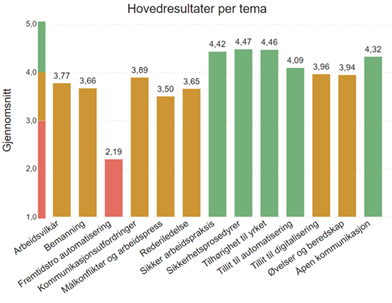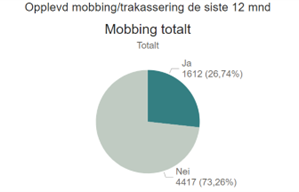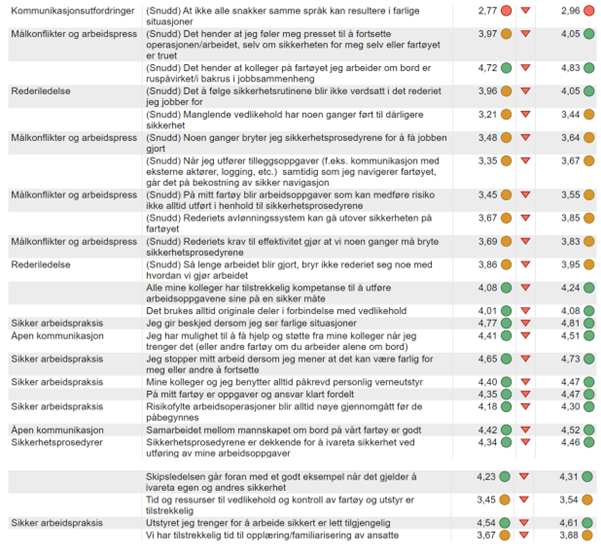MARITIME SAFETY: The survey provides employees working at sea with a chance to voice their opinions and assists the NMA in understanding how safety culture and different conditions may impact those who work at sea.
The results also provide the basis for planning supervisory activities and developing safety measures. This article provides an overview of the survey findings.
The general findings are relevant to the entire industry. Both shipping companies and organisations can take steps to improve some of these findings.
General findings

Several of the 13 topics received a relatively high scores, especially those directly related to safety, such as «Safe working practice», «Safety procedures» and «Open communication».
«Sense of belonging in the profession» also received a high score. However, the lowest score was assigned to the new issue concerning "Belief in the future - automation", measuring whether seafarers think autonomous vessels and increased automation will enhance safety. The low score indicates that those working at sea do not believe that greater autonomy and automation will improve safety. A detailed overview (in Norwegian) with graphs displaying the general findings can be found in this document.
Alarming levels of bullying and harassment
Around 27 per cent of all employees at sea have experienced at least one type of bullying or harassment. For different vessel types (cargo ship, passenger ship and fishing vessel), the results vary from 19 to 32 per cent.
Within bullying/harassment issues, actions like sexual harassment, exclusion, personal criticism, mentioning of previous mistakes, criticism of work, inappropriate jokes aimed at individuals, talking behind a person’s back, and rumor spreading were defined.
The most common issues reported were gossip and rumors being spread (14 per cent) and personal criticism (11 per cent).

2 per cent of all employees at sea reported experiencing sexual harassment in the last 12 months. For the 400 women who responded to the survey, the percentage is 15.
Clearly, there is a need to address attitudes and the general working environment to prevent such incidents. This is crucial for job satisfaction, mental health, improved safety, and employee retention.
Responses are reflected in accident statistics
The survey reveals a negative trend regarding the share of employees at sea who have been in situations that could have resulted in a serious incident in the last 12 months, with as many as 362 persons answering yes to this question. This trend corresponds with the accident statistics for commercial vessels, showing a 9 per cent increase in reported near-accidents from 2021 to 2022.
There is also a minor negative change in the share of employees at sea carrying out risk assessments prior to risky work operations compared to previous years. Despite the NMA's focus on safety culture and risk understanding in the last two years, a positive change was expected.
There is a small, but positive change in the number of employees at sea working more than 14 hours a day every week or more often, as fewer people answered yes to that question. However, a staggering 1,269 persons, almost 18 per cent of the total number of respondents, report working more than the general permitted hours.
Company managements should address the negative trend
Responses to individual questions show a negative change for a total of 25 questions compared to 2021. For 5 of the questions, the trend is positive. Part of the explanation is minor changes to the questions and the conclusion of the global pandemic.

As many as 25 questions received significantly poorer scores in 2023 compared to 2021.
The NMA urges company managements to set a good example and focus on these challenges internally. In some cases, improving information or increasing employee involvement might be sufficient, while in others, a better plan for general safety work is required.
The highest and lowest scoring statements
Several individual statements related to safe working practice, access to safety procedures, support from the ship’s management in prioritising safety and cooperation, and the access to support in the work receive high scores. The same is true for statements related to a sense of belonging in the profession. This indicates that the safety culture is generally quite good.
Here are some of the highest-scoring statements, each with an average of more than 4 (out of 5):
- I act if I observe hazardous situations.
- Sometimes, my colleagues on board are working while intoxicated/hungover.
- I stop doing my work if I think it might be dangerous for me or others to continue.
- I have easy access to safety procedures related to my work.
- The equipment I need to work safely is easily available.
- I am proud to be a seafarer.
- I am confident that I have support from the ship's management if I prioritise safety in all situations.
- The cooperation between the crew members on board is good.
- Being a seafarer is part of my identity.
- I can get support from my colleagues whenever I need it (or from people on other vessels if the worker is the only person on board).
In contrast, the majority of negative responses are linked to statements related to a belief that autonomy and automation will lead to increased safety, and to statements related to the quality of internet access and welfare services. Among the safety aspects, a low score is given to statements related to different languages on board, incompatible tasks and a lack of maintenance.
There may be reason to believe that a positive psychosocial work environment will also enhance safety at sea.
These are examples of the lowest-scoring statements, each below 3.2/5:
- I believe that autonomous vessels will make shipping safer.
- The weather conditions are often challenging in the waters where we operate.
- More automation on board will have a positove effect on safety.
- The Wi-Fi on board is good enough for my use during leisure time.
- The fact that everyone does not speaks the same language could result in hazardous situations.
- The company has good welfare services.
- On my vessel, we have tasks that require us to «be in more than one place at the same time» (incompatible tasks).
A lack of communication may lead to accidents
The survey illustrated that hazardous situations may occur because more than one language is spoken on board. In early 2023, the Norwegian Safety Investigation Authority investigated a fatality following a fall overboard. Following the investigation, they strongly argued that a common working language is important to prevent misunderstandings.
Results for different vessel types
In future articles, we will take a closer look at the numbers for carho ships, passenger ships and fishing vessels with associated sub-categories of vessels. The results are already available (in Norwegian) in the attachments to this page.
